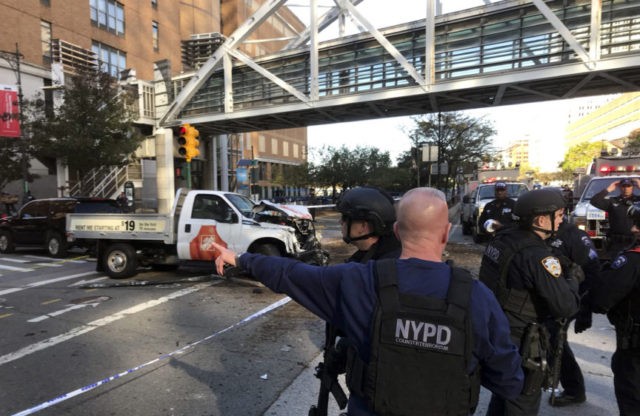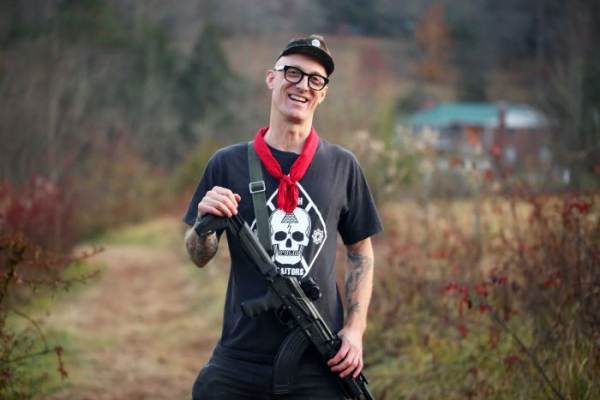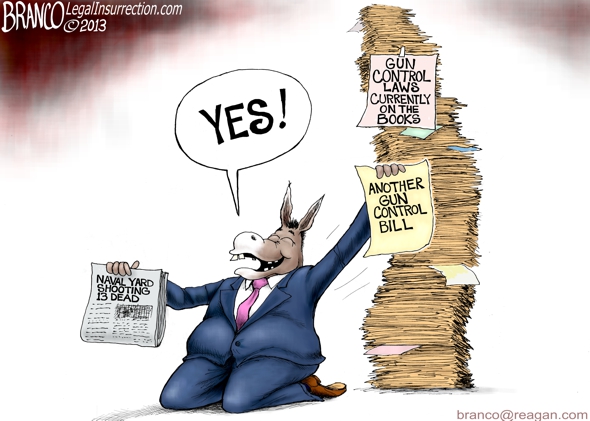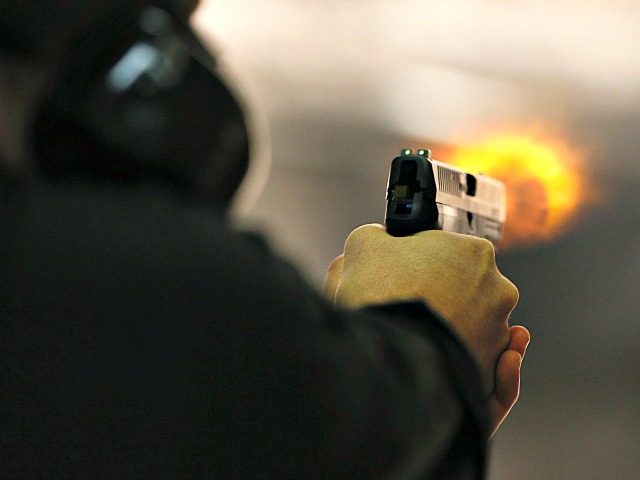With 2017 quickly drawing to a close, Breitbart News thought the timing right to review the top 25 defensive gun uses (DGUs) of 2017.
And while it must be noted that these 25 examples are only a smidgen of the hundreds of thousands of DGUs that occur each year–see the academic work of Florida State University’s Gary Kleck–they nonetheless present a well-rounded summation of the various locations and circumstances in which law-abiding citizens use guns to defend their own lives and the lives of others.
Here are the top 25 DGUs of 2017:
January 2, 2017–Kay Dickinson was attacked while entering her Wilmington, North Carolina, apartment. WWAY repoted that Dickinson had just gotten off work and was going into her apartment at Colonial Parke when she was attacked.” The suspect held her at gunpoint, “beat her and then tied her up with a broken belt in her bedroom.” She was able to work free, retrieve her gun, and kill the suspect.
January 12, 2017–An concealed carry permit holder saw an Arizona State Trooper being beaten on the side of Interstate 10. The permit holder pulled over, asked the Trooper if he needed help, then intervened when the Trooper answered in the affirmative. The permit holder ordered the attacker to stop, then shot him dead after he refused to comply. It turned out that the suspect had shot the Trooper before the permit holder arrived, then climbed on top of him in a rage and began beating him on the side of the road. The permit holder saved the Trooper’s life.
January 20, 2017–Charlotte, North Carolina’s Kim Badger was attacked in “broad daylight” by a home invasion suspect armed with a baseball bat. WCNC reported that the attacker struck Badger with the bat, then pursued her through the house. Throughout the attack Badger fought to deny the suspect control of a knife that was on a counter and, eventually, to deny him access to a sword. Badger’s teenage son joined the fight to keep the suspect away from the sword. As the son fought, the mother retrieved her gun and shot the suspect dead.
January 29, 2017–Two masked suspects entered West Philadelphia’s Eagele’s Corner Chinese takeout and “announced a robbery.” According to 6 ABC, police indicated that two store owners were present at the time and one of the owners pulled a gun and opened fire. The owner opened fire, causing both of the suspects to flee. One of the suspects was struck by the owner’s gunfire and was arrested after his accomplice drove him to the hospital for treatment.
February 9, 2017–A legally armed citizen in Holland, Michigan, shot and critically wounded a suspect who would not stop assaulting a woman inside a convenience store. Holland Police issued a press release recounting the incident by explaining that “the suspect violently punched the victim several times and threw her down to the ground, and it is at that point that the [armed] customer arrives and tries to intervene.” The suspect then turned and attacked the customer who was trying to intervene, leading the customer to open fire. The suspect was shot twice and hospitalized in critical condition.
March 8, 2017–A home invasion suspect who approached a family was shot and killed by the father after refusing to accept food stamps in lieu of money. WBRZ quoted East Baton Rouge District Attorney Hillar Moore saying, “The [father] was at his own home with his family and was confronted by another individual who was armed. There was a scuffle which eventually led to shots being fired and the person who came to the home was shot and killed.” The father offered the suspect food stamps prior to fighting and eventually killing him.
March 9, 2017–A Houston, Texas, smoke shop owner was shot multiple times yet managed to pull his own gun and kill one of two robbery suspects. ABC 13 reported that customers were in the store when the two suspects entered. Those customers called 911 and the dispatcher could hear the sound of gunshots in the background. The store owner was hospitalized in critical condition after the uninjured suspect fled the scene.
March 21, 2017–A 21-year-old suspect kicked in his ex-girlfriend’s apartment door, then died after being shot multiple times. As it turns out, the ex-girlfriend’s brother was in the Detroit apartment and opened fire on the suspect. Police responded to find the suspect had a gun and had left his car parked in the street with the engine running.
April 14, 2017–A homeowner in Pierce County, Washington, awoke to the sound of someone trying to enter his home around 3:30 a.m. The homeowner retrieved a gun and went to investigate, ultimately firing one shot and killing 28-year-old Viktor Starovevrov. The Pierce County Sheriff’s Department responded to a call of shots fired and arrived to find Starovenrov beyond hope of survival. A 32-year-old woman and three-year-old girl were asleep in the house when the invasion was foiled.
April 23, 2017–A St. Louis 7-11 clerk was taking a smoke break around 3:50 a.m. when a robbery suspect approached and attempted to rob her. The clerk pulled her own gun and exchanged fire with the suspect, shooting him multiple times. The suspect’s wounds proved fatal. The clerk was also wounded in the gunfight, yet was in stable condition following the incident.
May 3, 2017–An Arlington, Texas, man described by witnesses as an “active shooter” was shot and killed by a concealed carry permit holder in Zona Caliente Sports Bar around 6:15 p.m. WFAA reported that the armed suspect shot and killed the bar manager and was then was engaged by the permit holder, who shot the aggressor dead. Police explained that the permit holder intervened out of fear that inaction would lead to a further “loss of life.”
May 12, 2017–A female homeowner shot and killed a suspect who allegedly brought his sevem-year-old son along for the home invasion. The San Antonio Express-News reported the suspect allegedly tried to break in through a window in the very room where the homeowner happened to be asleep. The woman heard the suspect trying to make entry into her home, armed herself, and fired at least two rounds. Police arrived in time to transport the alleged intruder to a hospital, where he was pronounced dead.
May 18, 2017–A home invasion suspect wearing only underwear was shot and killed after breaking into a pastor’s home in Cypress, Texas. The suspect entered the home around 2:00 a.m. and attacked the pastor and his wife. As the intruder went room to room looking for other would-be victims, he came upon an extended family member who was armed. That family member shot and killed the intruder, saving others in the home from coming under attack.
May 29, 2017–An armed neighbor in Ada, Oklahoma, came to the rescue of three children who were being drowned by their father. Cash Freeman was alerted to the situation when a terrified 12-year-old ran to his house to say the estranged father had taken the children from the mother and was trying to drown them. Freeman arrived to find the father holding three-month-old twins under water. Freeman shot the father twice, killing him and saving the children.
June 7, 2017–An Indianapolis mother protected her children by opening fire and killing a home invasion suspect who struck in broad daylight. Fox 59 reports that the mother heard someone trying to get into the apartment, then came to face-to-fact with 19-year-old Michael Hawkins. She opened fire at that point and Hawkins dropped dead “inside the doorway.” The mother and the children were not harmed.
June 17, 2017–A man was shot and killed by his ex-girlfriend after he allegedly threatened her and showed up to her house with an “assault rifle.” The incident occurred in Florida’s Pasco County around 10:30 pm. According to Fox 13 News, law enforcement officials said 45-year-old Frank Harrison had “previously threatened his ex-girlfriend.” When she saw him approaching her home she opened the front door and shot him dead before he could enter.
July 17, 2017–With a car thief on the lose near her family’s home 17-year-old Kimber Wood called her dad and asked if she could retrieve one of his guns to keep close at hand for self-defense. Her father said yes, so Kimber retrieved the gun and was ready when the suspect entered the house. Kimber and the suspect came face to face, only to have to him flee when she pointed the gun at him and ordered him to leave the home. She chased him as he fled and fired a warning shot to assure him that she knew how to use the gun.
July 31, 2017–A Katy, Texas, grandma opened fire on two home invasion suspects, leaving one dead. According to ABC 13, Harris County Sheriff’s deputies said the 60-year-old grandma was home alone when two suspects allegedly entered through the garage. Deputy Thomas Gilliland said, “Both were armed with pistols. She confronted both suspects, retrieved a handgun and fired several times at both subjects.”
August 5, 2017–An elderly homeowner in Lakewood, Florida, shot and killed a home intruder. The homeowner was in the home with his wife when they heard the suspect make entry. He grabbed a gun, confronted the suspect, then killed him. Law enforcement officials did not report how many times the suspect was shot, only that he was dead when responding officers arrived.
September 6, 2017–Three Taco Bell employees opened fire and killed an armed robbery suspect in Cleveland, Ohio. According to Fox 8, police said two suspects entered the store “wearing masks and ordered the employees to the ground at gunpoint.” There were multiple employees in the store at the time and three of them responded by opening fire. When officers arrived the suspect who had been fatally wounded was lying face down and a gun was still in his hand.
September 14, 2017–An Indianapolis father shot and killed an intruder who burst through the front door and rushed into the apartment. The father’s two young children were home at the time of the foiled invasion. CBS 4 quoted Indianapolis Metropolitan Police officer Aaron Hamer, who said, “It appears [the suspect] was yelling to get into the residence because he believed his kids were in the house. It turns out the kids inside did not belong to him.” The father and his two children were not harmed.
September 18, 2017–A female accountant shot and critically wounded a suspect who broke into her office as she was there typing alone. The suspect was fleeing police when he entered the office and the accountant asked to stop coming at her before she pulled the trigger and shot him in the neck. The suspect survived being shot, but has to undergo rehab to learn how to walk again.
September 24, 2017–Two home invasion suspects rushed into a Bridgeville, Maryland, home around 11:55 pm. Police indicated that at least one of the suspects was armed. The homeowner, home alone at the time off the invasion, wrestled with the armed suspect and shot was fired, killing the suspect. The suspect’s body was lying in the kitchen when police arrived. The homeowner was not injured.
November 5, 2017–Stephen Willeford was in his home in Sutherland Springs, Texas, when his daughter rushed inside to let him know someone was shooting congregants at the First Baptist Church. Willeford grabbed his AR-15 and a handful of bullets and ran barefoot toward the church in order to confront the killer. Upon arriving, Willeford took a defensive position behind a truck and exchanged fire with the killer, shooting him twice. The killer fled the scene after Willeford shot him, driving roughly 11 miles before taking his own life. Willeford proved anew the only thing that stops a bad guy with a gun is a good guy with a gun.
December 6, 2017–A father with a handgun license shot and killed an armed suspect who confronted the father and his family in a Popeye’s restaurant. According to Fox 29, the suspect pointed a gun at the father and “demanded his property.” The father asked that his family be released, then pulled his own gun when the suspect became distracted by individuals walking out the restroom. The father shot the suspect multiple times, killing him on the spot.
The Second Amendment is not about duck hunting or plinking, but protecting our lives and liberty from threats as they arise. The top 25 defensive gun uses of 2017 show that law-abiding Americans understand this and are putting their guns to good use.
AWR Hawkins is an award-winning Second Amendment columnist for Breitbart News, the host of the Breitbart podcast Bullets, and the writer/curator of Down Range with AWR Hawkins, a weekly newsletter focused on all things Second Amendment, also for Breitbart News. He is the political analyst for Armed American Radio. Follow him on Twitter: @AWRHawkins. Reach him directly at awrhawkins@breitbart.com.
 SUPPORT NRA-ILA
SUPPORT NRA-ILA














